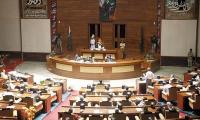PESHAWAR: A subcommittee under the Prime Minister’s 25-member committee on medical education has recommended against the establishment of new public sector medical colleges, suggesting instead the development of medical institutions in remote rural areas through public-private partnerships.
This recommendation is part of the subcommittee’s recent report, following meetings held on June 3 and 6, 2024. In May 2024, the prime minister constituted the committee, chaired by Deputy Prime Minister Senator Ishaq Dar, with the ToRs to assess the demand and supply gap, to review the standards of recognition for private sector medical colleges, to examine the phenomenon of students enrolling in unrecognised foreign institutions and propose policy options, and to suggest measures to improve the regulatory framework between public and private sector medical institutions to ensure uniform quality of education.
During its initial meeting, the committee formed a subcommittee to draft a brief on the mentioned ToRs.The subcommittee has since made nine recommendations, with a key recommendation being that the government should not establish new public sector medical colleges, citing an adequate number of existing institutions. However, it suggested that medical colleges could be established in rural areas such as Gilgit-Baltistan and Balochistan through public-private partnerships.
Ironically, the subcommittee failed to mention regions like Bajaur, Landikotal, Parachinar, and Miranshah, which already have adequate infrastructure for medical colleges. In comparison to Pakistan, India has the largest number of medical colleges globally, increasing to 706 in 2023 from 612 in 2022, with an annual intake of around 100,000 students.
Iran, with one medical school for every 1.5 million people, plans to increase medical school enrollments by 20 percent by 2024, ensuring 9,000 additional enrollments. Pakistan has 124 medical colleges with approximately 17,000 annual enrollments. Although girl students make up 70 per cent of these enrollments, only 23 pc practice medicine after graduation.
Additionally, around 40 pc of graduates either settle abroad or pursue postgraduate training overseas. Currently, approximately 10,000 Pakistani students receive medical education abroad, primarily in China, costing $70 million annually.
To address these issues, it is proposed that medical schools with at least 100 students be established in every district. This approach would meet local demand, improve healthcare services closer to home, and enable Pakistan to contribute significantly to the global market. Exporting skilled healthcare professionals would earn foreign exchange and enhance Pakistan’s global image, resulting in political and social benefits. However, medical colleges should be viewed as catalysts for local economic growth. Establishing a medical college would create direct and indirect jobs, promote businesses such as hotels, eateries, laboratories, pharmacies, and transport services, and save foreign exchange currently spent on overseas medical education.
To overcome the problems in establishing new medical colleges in the country, the retirement age should be increased from 60 to 70 years to retain experienced faculty; and modifying the criteria for assistant professors to either 2 years of postgraduate experience or two research papers, rather than both. Also, clinicians should be allowed to teach relevant basic sciences and the hiring of faculty assistants to fill gaps in required faculty.
However, the subcommittee’s recommendation for part-time faculty conflicts with the Pakistan Medical and Dental Council’s (PMDC) requirement for full-time faculty registration. This discrepancy could lead to chaos, with full-time faculty at one college being hired part-time by another. Moreover, the fee structure for new medical colleges should be set at half that of private medical colleges to ensure financial sustainability.
In districts with significant government investment, medical schools should be established by the government. In districts with minimal government investment, medical schools should be set up through public-private partnerships, with the government funding the district headquarters hospital affiliated with the medical school.
This is a representational image of candles. — CanvaPESHAWAR: Humayun Khan, the elder brother of senior...
Representational image of the transmission lines. — AFP FilePESHAWAR: In a bid to improve the electricity...
Commissioner Gujranwala Division Syed Naveed Haider Shirazi seen in this image on June 27, 2024. —...
Policemen stand guard after a protest in Lahore on May 11, 2023. — AFPFAISALABAD: Two alleged robbers were killed...
This picture shows labourers picking cotton in a field at Sammu Khan Bhanbro village in Sukkur, Sindh. —...
Medical Teaching Institute of Qazi Hussain Ahmad Complex OPD block can be seen image released on September 21, 2022....







